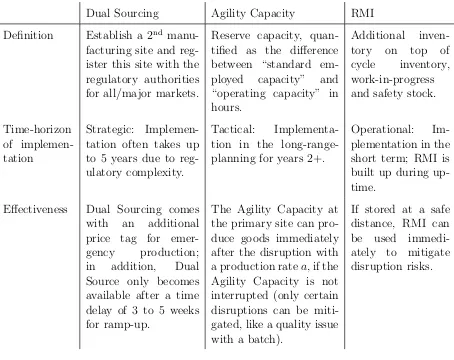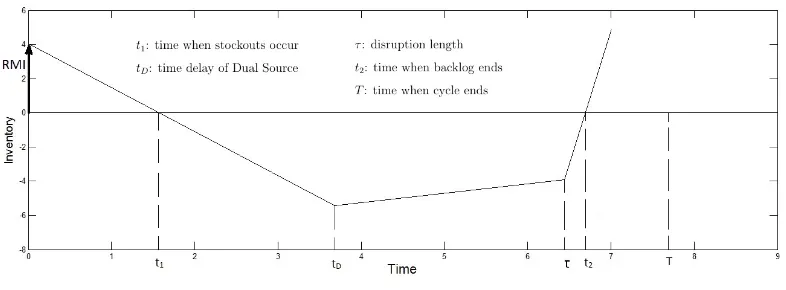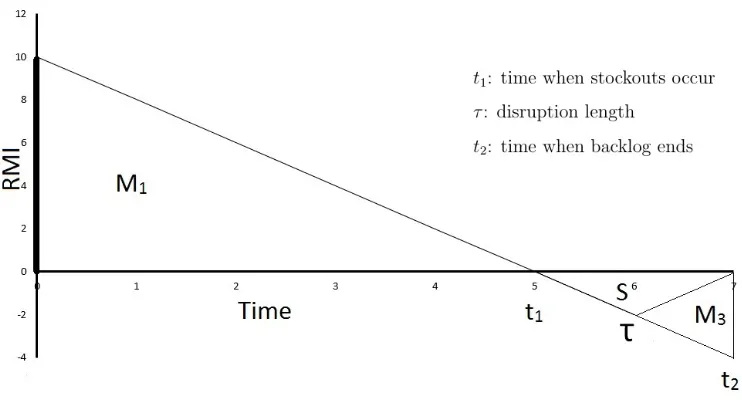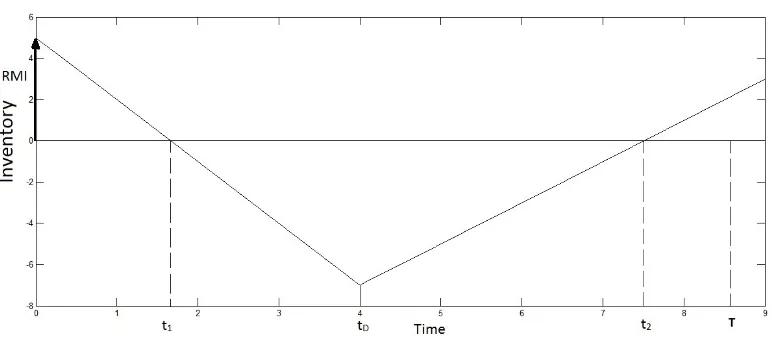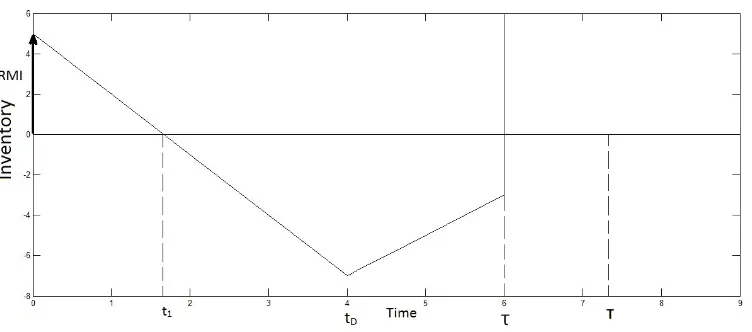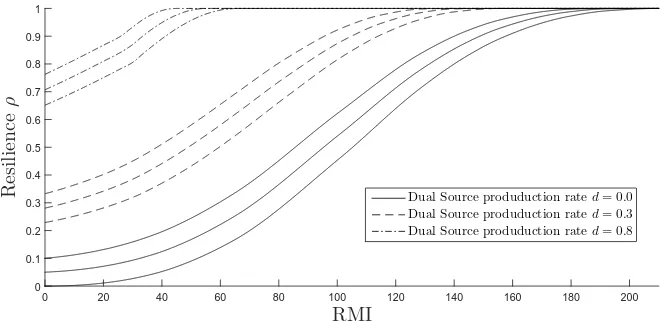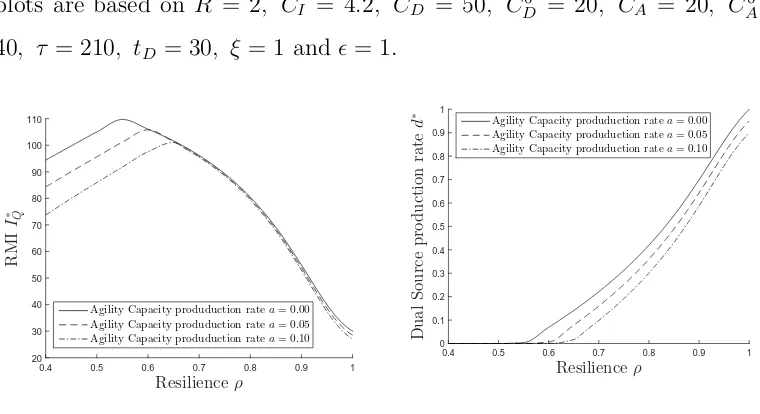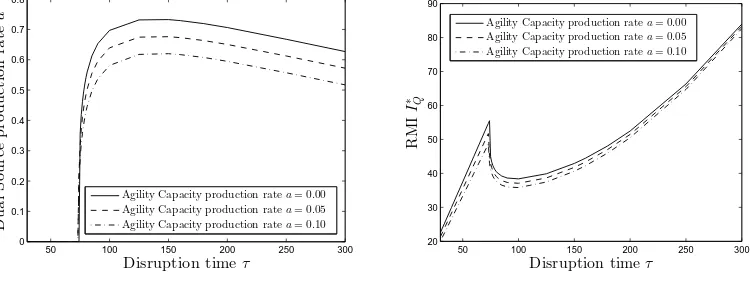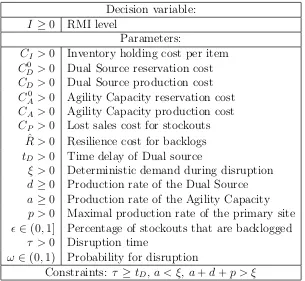City, University of London Institutional Repository
Citation
:
Lucker, F. & Seifert, R. W. (2017). Building up Resilience in a Pharmaceutical Supply Chain through Inventory, Dual Sourcing and Agility Capacity. Omega, 73, pp. 114-124. doi: 10.1016/j.omega.2017.01.001This is the accepted version of the paper.
This version of the publication may differ from the final published
version.
Permanent repository link: http://openaccess.city.ac.uk/19503/
Link to published version
:
http://dx.doi.org/10.1016/j.omega.2017.01.001Copyright and reuse:
City Research Online aims to make research
outputs of City, University of London available to a wider audience.
Copyright and Moral Rights remain with the author(s) and/or copyright
holders. URLs from City Research Online may be freely distributed and
linked to.
City Research Online: http://openaccess.city.ac.uk/ publications@city.ac.uk
Building up Resilience in a Pharmaceutical Supply Chain
through Inventory, Dual Sourcing and Agility Capacity
Florian L¨uckera,∗, Ralf W. Seiferta,b
aEcole Polytechnique F´´ ed´erale de Lausanne, Odyssea 4.16, Station 5, CH-1015 Lausanne bIMD, Chemin de Bellerive 23, P.O. Box 915, CH-1001 Lausanne
Abstract
This paper is inspired by a risk management problem faced by a leading
phar-maceutical company. Key operational risk mitigation measures include Risk
Mitigation Inventory (RMI), Dual Sourcing and Agility Capacity. We study
the relationship between these three measures by modeling the drug
man-ufacturing firm that is exposed to supply chain disruption risk. The firm
determines optimal RMI levels for assumed Dual Sourcing and Agility
Capac-ity. We quantify the decrease in RMI levels in the presence of Dual Sourcing
and Agility Capacity. Furthermore, using an example, we analyze RMI, Dual
Sourcing and Agility Capacity decisions jointly. It turns out that RMI and
Agility Capacity can be substitutes as long as no Dual Source is available.
Once the Dual Source is available, Agility Capacity and Dual Sourcing appear
to be substitutes. We further show that for long disruption times, the optimal
Dual Source production rate may decrease in the disruption time. Within
our modeling framework, we introduce an operational metric that quantifies
Supply Chain Resilience. Supply chain disruptions can have a severe business
impact and need to be managed appropriately.
∗Corresponding author
Keywords: Risk, Operations management, Inventory control, Application
1. Introduction
During the past decade, a significant increase in drug shortages has been
observed by the U.S. Government Accountability Office (GAO). Between 2007
and 2012 the number of active drug shortages in the U.S. grew from 154 to
456. The U.S. agency sees supply disruptions as the direct cause of supply
shortages (GAO, 2014). In Switzerland, where the pharmaceutical industry
plays an important role in the national economy, the government proposes
that all relevant drug shortages should be centrally reported (Schweizer Radio
und Fernsehen, 2014). Although pharmaceutical companies are committed to
providing a secure and continuous supply of medical products, they also face
shareholder pressure to operate cost-effectively.
The pharmaceutical industry is not unique. The focus on boosting
ef-ficiency in global supply chain networks has led to increasing vulnerabilities
across industries (Sodhi and Tang, 2012). Managing supply disruptions
appro-priately and building resilient supply chains have thus emerged as important
business challenges (WEF, 2013, 2012). While Supply Chain Resilience seems
to be a high priority for top management, many companies still appear to
manage supply disruptions in an ad hoc manner rather than viewing them
as an integrated part of operations (Seifert and L¨ucker, 2014). The lack of
clear Resilience metrics and quantitative decision tools contributes to many
companies’ hesitation when it comes to defining and implementing a holistic
Supply Chain Resilience strategy.
In this paper we use the pharmaceutical industry as an example to analyze
chain disruption risk. The main risk mitigation levers are: holding additional
inventory, so-called Risk Mitigation Inventory (RMI), and adding process
flex-ibility (Simchi-Levi et al., 2015). RMI is designed to be used to meet customer
demand in the event of a supply disruption. Our research focuses on
analyz-ing RMI and process flexibility decisions jointly for a pharmaceutical firm.
In this context, process flexibility refers to: 1) Establishing and qualifying a
second manufacturing site (Dual Source) in addition to the disruption-prone
first manufacturing site (primary site). In the pharmaceutical industry
“qual-ifying” means that the facility is registered for all/major markets with the
regulatory authorities. 2) Keeping a reserve capacity at the primary site for
emergency production, so-called Agility Capacity.
We develop mathematical models that determine analytically the optimal
RMI levels for an exogenously given process flexibility in terms of Dual
Sourc-ing and Agility Capacity. We show numerically that RMI and Agility
Capac-ity can be substitutes as long as no Dual Source is available. Once the Dual
Source is available, Agility Capacity and Dual Sourcing appear to be
substi-tutes. We further show that for long disruption times, the optimal Dual Source
production rate may decrease in the disruption time. Within our modeling
framework, we introduce an operational metric that quantifies Supply Chain
Resilience. Our models incorporate pharma-specific regulatory constraints and
production assumptions that are motivated by a research collaboration with a
leading pharmaceutical company. Our work was then applied to pilot projects
to assess the Supply Chain Resilience of life-saving drugs.
Our main contribution to the literature is to jointly analyze RMI and
process flexibility decisions in the context of disruption risks. While RMI and
process flexibility have been studied separately in the literature, little work has
insights on the sensitivity of the optimal risk mitigation strategy in model
parameters such as disruption time or Resilience metric.
In the next section we describe the business setting of the pharmaceutical
company and state our research questions. In section 3, we provide a
litera-ture review that focuses on Supply Chain Resilience and the pharmaceutical
supply chain. We then present our mathematical models in section 4. We
distinguish between a general model and two specific cases which arose in our
research collaboration with the pharmaceutical company. To foster additional
managerial insights, we provide numerical examples in section 5. Finally, we
conclude this paper with recommendations for future research.
2. Business motivation and research questions
Having collaborated from the outset with a leading pharmaceutical
com-pany, we had the opportunity to analyze its Supply Chain Resilience strategy
in detail. Given that the implementation of such a strategy not only has direct
implications for patients’ safety but also requires substantial capital
expendi-tures and data collection, Supply Chain Resilience is a topic that has board
level attention. The company’s motivation to address Supply Chain Resilience
is multifold, ranging from financial aspects (high product margin) to
regula-tory requirements to ethical aspects (reliable supply of life-saving drugs to
patients).
To put costs into perspective, we cite the 2015 annual report of another
pharmaceutical company, Pfizer (http://www.pfizer.com/investors): the innovative pharmaceutical segment has an average cost of sales of 11.2% of
revenues (page 42). Annual sales of products in this segment typically exceed
1 bn USD. For example, Pfizer’s Lyrica drug generated 4.8bn USD revenue in
demand could not be met because of a disruption. Our industrial partner
fo-cuses its Supply Chain Resilience strategy on its key products from a financial
and patient safety (life-saving drugs) perspective.
Resilience measures are predominantly implemented during the mature
stage of the product life cycle, when the demand rate is stationary and can be
approximated as constant for limited time periods. During the growth phase
of the product life cycle, when the product faces non-stationary stochastic
demand, practitioners focus their efforts on meeting demand and building up
production capabilities. At the end of the product life cycle (decline phase),
divestment strategies are undertaken.
To achieve Resilience, our industrial partner focuses on three risk
mitiga-tion levers, which are under the company’s direct control (see Table 1): Dual
Sourcing, Agility Capacity, and Risk Mitigation Inventory (RMI).
To assess Supply Chain Resilience on a product level, the company sets
targets for each Resilience lever separately. The Dual Sourcing lever is
mea-sured in terms of market coverage of the Dual Source with respect to market
registrations. An Agility Capacity of 20% is targeted for the various
manu-facturing sites, and RMI is determined by covering the 95th percentile of a
so-called Disruption Risk Profile (see below). The company has no
methodol-ogy in place to determine how the Resilience levers relate to one another, e.g.
to what extent RMI can be decreased in the presence of Dual Sourcing and
Agility Capacity.
The idea behind the Disruption Risk Profile is to assess a manufacturing
site’s ability to recover from a variety of operational and catastrophic events.
Such an event could be a biological contamination within the manufacturing
site, a quality issue, or a natural hazard. These events are typically rare (less
Dual Sourcing Agility Capacity RMI
Definition Establish a 2nd
manu-facturing site and reg-ister this site with the regulatory authorities for all/major markets.
Reserve capacity, quan-tified as the difference between “standard em-ployed capacity” and “operating capacity” in hours.
Additional
inven-tory on top of
cycle inventory, work-in-progress and safety stock.
Time-horizon of implemen-tation
Strategic: Implemen-tation often takes up to 5 years due to reg-ulatory complexity.
Tactical: Implementa-tion in the long-range-planning for years 2+.
Operational: Im-plementation in the short term; RMI is built up during up-time.
Effectiveness Dual Sourcing comes with an additional price tag for
emer-gency production;
in addition, Dual
Source only becomes available after a time delay of 3 to 5 weeks for ramp-up.
The Agility Capacity at the primary site can pro-duce goods immediately after the disruption with a production ratea, if the Agility Capacity is not interrupted (only certain disruptions can be miti-gated, like a quality issue with a batch).
[image:7.612.111.565.208.568.2]If stored at a safe distance, RMI can be used immedi-ately to mitigate disruption risks.
can have a significant impact by causing a long disruption time (i.e. typically
longer than four weeks). As a first step, the following data is collected for all
relevant risk events that might cause supply disruptions: probability of the
event and impact in terms of length of supply disruption. Probability and
impact are determined for three scenarios: best, worst, and most likely case.
This data is based on past records, a survey with the manufacturing sites, and
commercially bought insurance data. The results are fed into a Monte Carlo
simulation leading to a so-calledDisruption Risk Profile that provides the
cu-mulative probability distribution function for the maximal disruption time in
a given year. The company has conducted this Disruption Risk Assessment
for several key sites. Given the range of input factors being considered,
man-agement has decided to cover the 95th percentile of aDisruption Risk Profile
with RMI.
Based on our experience with the company, we formulate our main research
questions:
1. Can we define a holistic quantitative Resilience metric that considers
RMI and process flexibility jointly?
2. What are optimal RMI levels if process flexibility is exogenously given
in terms of Dual Sourcing and Agility Capacity?
3. How does the optimal risk mitigation strategy depend on parameters
such as disruption time and Resilience metric?
3. Literature review
Two major literature streams are relevant to our research: the managerial
and academic literature on Supply Chain Resilience, which serves as the main
disruption risk management, inventory control systems, Agility Capacity and
Dual Sourcing.
The Supply Chain Resilience literature introduces different definitions,
which we briefly summarize. A supply chain disturbance is defined as “a
foreseeable or unforeseeable event, which directly affects the usual operation
and stability of an organization or a supply chain” (Barroso et al., 2008).
These disturbances concern not only the flow of goods but also information
and financial flows. In this context, it is common to define supply chain
vul-nerability “as the incapacity of the supply chain, at a given moment, to react
to the disturbances and consequently to attain its objectives” (Azevedo et al.,
2008).
Disturbances make a supply chain more vulnerable and they might affect a
company’s performance not only in terms of direct financial losses but also in
terms of negative corporate image and loss in demand. Hendricks and Singhal
(2005a, 2005b) use an empirical approach to quantify the effect of supply
chain disruptions on the long-run stock price performance. Analyzing a period
starting one year before the disruption and lasting until two years after the
disruption, they find that the average abnormal stock return after disclosing a
supply disruption was nearly -40%. Furthermore, share price volatility, which
can be taken as an indicator of equity risk, increased by 13.50% during the
subsequent two years.
In order to address the problem of vulnerability, scholars describe the
con-cept of Resilience in the supply chain as “the ability [of a supply chain] to
re-turn to its original state or move to a new, more desirable state after being
dis-turbed” (Christopher and Peck, 2004). While risk management often focuses
on high probability, low impact operational risks, Supply Chain Resilience
of these risks is considered to be increasing because of the inter-connectivity
of global supply chain networks (WEF, 2013). A key lever for achieving
Re-silience is seen in operational risk management, which is identified as the “most
important risk domain” (van Opstal, 2007) and is the focus of this paper.
For a general overview of risk management we refer to the relevant
litera-ture. Tang (2006) presents a general overview of supply chain risk management
and mitigation strategies, whereas Dong and Tomlin (2012) provide a
litera-ture review of the operational disruption management literalitera-ture. While some
authors analyze inventory management for single systems (Moinzadeh and
Aggarwal, 1997) or multi-location systems (Schmitt et al., 2015), this paper
focuses on analyzing jointly the operational measures of RMI, Dual
Sourc-ing and Agility Capacity. The relevance of balancSourc-ing inventory and capacity
decisions is pointed out by Chopra and Sodhi (2004).
Within the operations management literature, several authors have linked
Dual Sourcing with inventory decisions, or capacity decisions with inventory
decisions under specific circumstances. On the procurement side, Tomlin
(2006) analyzes a firm that can source from two suppliers and explores
pa-rameters like reliability of the supplier and volume flexibility. This work
com-plements papers that analyze Dual Sourcing decisions, e.g. (Ramasesh et al.,
1991; Chen et al., 2012; Silbermayr and Minner, 2014; Allon and Van Mieghem,
2010; Berger et al., 2004; Ruiz-Torres and Mahmoodi, 2007; Yu at al., 2009;
Sawik, 2014). These models provide powerful tools for analyzing procurement
decisions. However, our research focuses on Dual Sourcing within the
manu-facturing process, for which the assumptions and parameters differ from the
abovementioned models. Capacity and inventory decisions under seasonal
de-mand are analyzed in (Bradley and Arntzen, 1999), where the authors use a
The propagation of disruption in a network is analyzed by Liberatore et al.
(2012). Similarly, Simchi-Levi et al. (2015) analyze supply chain robustness for
different network configurations in terms of process flexibility and inventory.
Their work is based on a two-stage robust optimization model.
The interface between operational measures and business insurance is
an-alyzed by Dong and Tomlin (2012). The authors include inventory decisions
and emergency sourcing in their model. However, some assumptions differ
from our purely operational model. Some parameters that are relevant to our
model, such as time delay and finite production rate of the Dual Source, are
not considered because of their focus on insurance policies.
While there is some academic literature on modeling disruption risks,
link-ing the three mitigation measures in the context of risk management seems to
be relatively unexplored. The need for a Resilience metric is pointed out in
various managerial journals (WEF, 2012).
4. Mathematical model
The model we present in this section assumes that the firm produces a
single product and that the production is subject to disruption risk. Such a
disruption could have an internal cause such as a biological contamination at
a productions site or an external cause such as an earthquake. To mitigate
a disruption, the firm builds up RMI and process flexibility. RMI is used to
serve unmet demand instantaneously during a potential disruption. The Dual
Source and the Agility Capacity (process flexibility) allow for production after
a disruption has occurred.
RMI is typically considered an efficient risk mitigation lever for short
are efficient risk mitigation levers because carrying excessive RMI over time is
less economical.
We assume that the primary site of a single firm is exposed to a severe
disruption of length τ during a cycle of lengthT with τ < T. The disruption
occurs with probability ω. Given the low probability for such a disruption
(ω < 5%), we assume that only one disruption occurs during a cycle. This
assumption is in line with prior literature that explicitly excludes the case
that two disruptions occur simultaneously (see, for example, Simchi-Levi et
al. (2014); Hu and Kostamis (2015); Asian and Nie (2014); and Simchi-Levi et
al. (2015), p. 7 for a discussion of this assumption). During the disruption we
assume that approximate constant demand takes place, since we are focusing
on the mature stage within the life cycle of the key product.
We develop mathematical models that analytically determine optimal RMI
levels for an exogenously given process flexibility. We choose the RMI level as
our main decision variable because this variable can most easily be adapted in
practice (operational decision). Decisions regarding process flexibility are often
of a strategic/tactical nature and are not taken solely based on a mathematical
model. For completeness, however, we provide numerical results for a specific
case that jointly evaluates optimal RMI, Dual Sourcing and Agility Capacity
decisions. Our mathematical model assumes the following:
1. The primary site of a single firm is exposed to a disruption during a
cycle, with probability ω and disruption time τ.
2. The Dual Source can produce goods in an emergency case with a
pro-duction rate d. This Dual Source only becomes available after a time
delay tD (Table 1).
after the disruption with a production rate a, if the Agility Capacity is
not interrupted.
4. For mature products, demand ξ is approximately constant during the
disruption time.
5. The proportion of backlog orders to total demand is given by ∈(0,1].
6. RMI is held decentrally in a safe location (i.e. at the next manufacturing
stage) and is thus not interrupted by the disruption.
To avoid trivial solutions, we further assume thatτ ≥tD,a < ξ, anda+d+p >
ξ. The time delay of the Dual Source (assumption 2) is due to scheduling
re-strictions and the lead time of production, including quality release. For a
pharmaceutical company this delay can easily amount to 3 to 5 weeks.
Re-garding assumption 3, the availability of the Agility Capacity depends on the
disruption type. For example, a quality issue represents a major risk in some
pharmaceutical manufacturing stages within the supply chain. For such cases,
the Agility Capacity can become a viable mitigation lever as the primary site
itself is not necessarily affected. In our mathematical models, we can always
switch off the Agility Capacity by setting the relevant parameters to zero.
Assumption 6 ensures that RMI is not destroyed by the disruption. RMI
is typically stored at the next manufacturing stage, which is geographically
distant from the possible disruption location.
4.1. Analysis of the disruption phase and Resilience metric
In Figure 1 we display a single disruption that takes place at time t = 0.
For a given level of RMI, we can immediately mitigate the disruption until
RMI is depleted at time t1. Starting at time tD the Dual Source produces
goods with production rate d (with d > ξ being shown in Figure 1). At time
Agility Capacity produces goods with a production rate a during t0 and t2 if
[image:14.612.112.505.157.302.2]the Agility Capacity is available. The backlog ends at time t2.
Figure 1: General model showing inventory levels over time
When defining a Resilience metric, we agreed with the pharmaceutical
company that, together with the stockout quantity, the stockout time itself is
important. Rather simplistic Resilience metrics such as two separate metrics
for the relative stockout time (e.g. t1
t2, Figures 2, 3) and the projected service
level during the stockout time might not lead to satisfactory results. A metric
based on the relative stockout time might indicate a low Resilience score even
if only a few stockouts occur, spread evenly over the disruption time. Hybrid
performance measures that include stockout quantity and time have previously
been studied in the context of the service level (Schneider, 1981). Motivated
by these hybrid performance measures, we define the operational Resilience
metric ρ as
ρ= M
M +S. (1)
Figures 2, 3 for an illustration),
S =−
Z t2
t1
I(t)dt
whereI(t) is the RMI level at timet. Note thatI(t) can be negative fort > t1.
The surfaceM is the area that has been successfully mitigated (see Figures 2,
3 for an illustration).
M =M1 +M2+M3 =
Z t1
0
I(t)dt+
Z τ
tD
tddt+
Z t2
τ
t(d+p)dt,
where the first part originates from the RMI, the second part from the Dual
Source and the third part from the primary site during the recovery phase.
We have:
Lemma 1. We have: ρ ∈[0,1], dρdI >0, and dρda > dρdd >0. If no Dual Source
is used we have: (i) ρ = 0 iff I = 0 and (ii) ρ = 1 iff I = t2ξ. If no RMI is
held, we have: (iii) ρ= 0 iff d= 0 and (iv) ρ <1 if d=ξ.
Proof. All results follow fromM = 12Iξ2 + (τ−tD)2d+τ2a+ (t2−τ)2(a+d+p)
Figure 2: Stockout and mitigation surface without a Dual Source
Figures 2 and 3 illustrate that for an increased RMI or for a quicker and
stronger Dual Source, the surfaceM increases, whereas the surfaceSdecreases.
This metric is applied to the disruption time τ to visualize the company’s
capability to mitigate disruptions in a worst case scenario. Illustrative
exam-ples of the metric are presented in section 5.
To include the stockout time in our optimization problem, we define
Re-silience cost as
CR=−Rˆ
Z t2
t1
I(t)dt, (2)
with a penalty cost per item and time, ˆR. Note that RMI I(t) is negative
between timet1 and t2. This Resilience cost makes it possible to minimize the
“surface of stockouts” (area of negative inventories betweent1 andt2 in Figure
1) under further cost considerations. Such a penalty cost has been applied for
Figure 3: Stockout and mitigation surface with a Dual Source
4.2. General model
Our model is based on minimizing total costs over one cycle (e.g. one
year) for a single firm that is exposed to disruption risk. The firm decides
RMI levels before a disruption takes place. Process flexibility decisions are
exogenously given. While some cost components (reservation cost for Dual
Source and Agility Capacity) are incurred regardless of whether a disruption
occurs, other cost components are only incurred when the disruption takes
place (emergency production costs through Dual Source or Agility Capacity).
Inventory holding costs CI are only incurred as long as no disruption occurs.
Further cost parameters are: Dual Source reservation costC0
D and Dual Source
production costCD, Agility Capacity reservation costCA0 and Agility Capacity
production cost CA, a lost sales cost for stockouts CP, and a Resilience cost
The expected total cost function is
C(IG) = ˆCI(IG) + ˆCD(IG) + ˆCA(IG) +CP(IG) +CR(IG). (3)
We distinguish between two cases:
• Short time delay: tD < t1
• Long time delay: tD ≥t1
Note that t1 depends on our decision variable IG. In the following we assume
thattD < t1. At the end of this section we fully characterize this case in terms
of model parameters only. The case tD ≥t1, which follows a parallel analysis,
will be treated in the appendix. In addition, we assume that a+d < ξ. This
assumption will be relaxed in section 4.2.2.
The first cost component of Eq. 3 is the inventory holding cost, which is
incurred over the entire cycle as long as no disruption occurs.
ˆ
CI(IG) = CIIG(1−ω) (4)
whereω is the probability that a disruption occurs. Note that these inventory
holding costs are only an approximation. For a more precise treatment, one
could replace CI(1− ω) → CI(1− ω) + CIω12 + CIω(1− Tτ). The CIω12
term reflects the situation that inventory holding costs are incurred during the
disruption time when inventory is carried for at least some of the disruption
time. TheCIω(1−Tτ) term reflects the situation that RMI might still be held
for part of the disrupted cycle time. For simplicity, we will refer only to CI,
The Dual Source production cost consists of two components: a fixed
amount for reserving the free capacity, which is incurred over the entire cycle
regardless of whether a disruption occurs; and an additional production cost
per item that is incurred only if the disruption takes place.
ˆ
CD(IG) =CD0d+CDd(t2−tD)ω. (5)
Similarly, the Agility Capacity cost splits into two parts.
ˆ
CA(IG) =CA0a+CAat2ω. (6)
The lost sales cost is incurred for the (1−) part of the effective demand
(ξ−a−d) during the time interval (t1, τ), when lost sales occur.
ˆ
CP(IG) =CP(ξ−a−d)(1−)(τ −t1)ω. (7)
The Resilience cost consists of two parts. One part arises during the time
interval (t1, τ), before the primary site recovers. The other part originates from
the remaining backlog once the primary site recovers (time interval (τ, t2)).
CR(IG) = ˆR
Z τ−t1
0
(ξ−a−d)tdt+
Z t2−τ
0
(n+ (ξ−a−d−p)t)dtω, (8)
where n is the backlog at time τ,
The starting time of stockouts t1 is given by setting supply volumes equal to
demand volumes.
IG+at1+ (t1−tD)d=ξt1,
which becomes
t1 =
IG−dtD
ξ−a−d. (9)
The time when the backlog ends, t2, consists of two components. One is the
disruption time τ and the other is the time to serve all outstanding backlogs
once the site has recovered.
t2 =τ +
n
a+d+p−ξ. (10)
Our general model gives an explicit analytic expression for the optimal
RMI level IG∗ depending on Dual Sourcing and Agility Capacity parameters.
Using first and second order conditions for the expected total costs (Eq. 3)
leads to
I
G∗=
−CI(1−ω)
ω +CP(1−)+
CAa+CDd
a+d+p−ξ + ˆR(
(ξ−a−d)(τ−tD)
a+d+p−ξ +τ+ dtD ξ−a−d) ˆ
R(a+d+p−ξ+ξ−a1−d)
.
(11)
Note that ˆR < CI (1−ω)
ω −CP(1−)−CAa
+CDd
a+d+p−ξ
(ξ−aa+−dd+)(pτ−−ξtD)+τ would result in negative optimal RMI levels. Note further that the condition tD < t1 (short time delay) is satisfied
if and only if
−CI(1−ωω)+CP(1−)+CAa
+CDd
a+d+p−ξ + ˆR(
(ξ−a−d)(τ−tD)
a+d+p−ξ +τ+ dtD ξ−a−d) ˆ
R(a+d+p−ξ+ξ−a1−d)(ξ−a)
> t
D.
(12)
We find in general:
CI(1 −ω)
ω −CP(1−)−
CAa+CDd
a+d+p−ξ
(ξ−aa+−dd+)(pτ−−ξtD)+τ , and for an exogenously given process flexibility, the
optimal RMI IG∗ is given by
IG∗ =
−CI(1 −ω)
ω +CP(1−)+CAa
+CDd
a+d+p−ξ+ ˆR(
(ξ−a−d)(τ−tD)
a+d+p−ξ +τ+ξ−dtDa−d) ˆ
R(a+d+p−ξ+ξ−a1−d) for short time delay
−CI(1 −ω)
ω +CP(1−)+CAa
+CDd
a+d+p−ξ+ ˆR(
(ξ−a)tD+(ξ−a−d)(τ−tD)
a+d+p−ξ +τ) ˆ
R(a+d+p−ξ+ξ−1a) for long time delay.
(13)
Proof. We refer to Appendix B for the case long time delay.
Numerical results and managerial insights are discussed in section 5. In
collaboration with the pharmaceutical company we reached the conclusion that
the following two cases are relevant for applications:
• Hot Standby case: the Dual Source is strong and the disruption ends
before the primary site restarts production (a+d > ξ).
• Quick Recovery case: the disruptions ends immediately once the primary
site starts producing goods again. This is relevant for applications in
which large batch sizes are produced (e.g. the production of the Active
Pharmaceutical Ingredient, API) and it is reasonable to assume that
p→ ∞.
In the following we discuss these two cases.
4.2.1. Hot Standby case
Here we address the special case that the Dual Source is strong and the
disruption ends before the primary site recovers, a+d > ξ (see Figure 4).
This can be the case, for example, when the Dual Source has sufficient excess
Figure 4: Hot Standby case: Dual Source/Agility Capacity takes over full production
The analysis of this case is similar to the general model. However, in
contrast to Proposition 1, we only have to consider the case long time delay
because the sum of the Dual Source and Agility Capacity production rates
is assumed to be greater than the demand rate. Hence, stockouts only occur
before the Dual Source starts production. Analogous to Proposition 1, the
starting time of stockouts t1 is given by
t1 =
IH
ξ−a, (14)
where IH is the RMI level. The maximal backlog n is given by
n = (ξ−a)(tD−t1)= ((ξ−a)tD−IH),
which leads to
t2 =
n
a+d−ξ +tD =
(ξ−a)tD−IH
Similar to the general model, we find:
Proposition 2. For a positive Resilience cost per item and per time Rˆ ≥
CI(1 −ω)
ω −CP(1−)−CAa
+CDd
a+d−ξ
tD(1+a+ξ−d−aξ) , and for an exogenously given process flexibility, the
optimal RMI IH∗ is given by
IH∗ =tD(ξ−a)−
CI(1
−ω)
ω −CP(1−)−
CAa+CDd a+d−ξ ˆ
R(ξ−1a+ a+d−ξ) . (16)
Proof. See Appendix C for a detailed proof.
Note that for ˆR→ ∞ we have
IH∗ =tD(ξ−a), (17)
which means that there is sufficient RMI to cover the whole disruption until
the Dual Source is qualified.
4.2.2. Quick Recovery case
In this case we assume that there are no more stockouts or backlogs once
the primary site is fully functional again (see Figure 5). In the pharmaceutical
industry this is the case, for example, when large batch sizes (e.g. API) are
produced.
For the general case we can take the limit p→ ∞and find:
Proposition 3. For a positive Resilience cost per item and per time Rˆ ≥
CI(1 −ω)
ω −CP(1−)
τ , and for an exogenously given process flexibility, the optimal
RMI IQ∗ is given by
IQ∗ =
(−CI(1−ωω)+CP(1−)+ ˆR(τ+ξ−dtDa−d))(ξ−a−d) ˆ
R for short time delay
(−CI(1 −ω)
ω +CP(1−)+ ˆRτ)(ξ−a) ˆ
R for long time delay
Figure 5: Quick Recovery case: Strong primary site
Proof. See Appendix D for a proof.
Note that the condition tD < t1 (short time delay) is satisfied if and only
if
−CI
(1−ω)
ω +CP(1−) + ˆRτ ˆ
R > tD. (19)
5. Numerical results
In this section we explore how different model parameters influence the risk
mitigation strategy. First, we provide an illustration of the Resilience metric.
Second, we analyze RMI and process flexibility decisions jointly. Third, we
perform a sensitivity analysis of our decision variable in relevant model
pa-rameters.
5.1. Definition of metric
We recall that the Resilience metric ρ is defined by stockout quantity and
stockout time. In Figure 6 we provide an illustrative visualization of the metric
of our resilience metric ρ (y-axis) depending on RMI (x-axis) for the Quick
Recovery case. There are three groups of lines for the different Dual Sourcing
scenarios (d= 0.0, d = 0.3, d= 0.8). Each group contains three lines for the
different Agility Capacity scenarios (a = 0.00, a = 0.05, a = 0.10). The plot
is based on the following further parameters: τ = 210, tD = 30, ξ = 1, d =
0.0, 0.3, 0.8, a= 0.00, 0.05, 0.10, = 1.
Figure 6 illustrates the extent to which RMI can be reduced if disruptions
are mitigated through Dual Sourcing and/or Agility Capacity if ρ is kept
constant. For example, at ρ= 0.8, RMI can decrease from RM I = 140 units
(no Dual Source or Agility Capacity) to RM I = 7 units (d = 0.8, a = 0.10).
The graph also illustrates how Resilience ρ increases if Dual Sourcing and/or
Agility Capacity increase while RMI is kept constant. For example, atRM I =
50 units, Resilience increases fromρ= 0.1 (no Dual Source or Agility Capacity)
toρ= 1.0 (d= 0.8,a= 0.10).
RMI
0 20 40 60 80 100 120 140 160 180 200
R
es
il
ie
n
ce
ρ
0 0.1 0.2 0.3 0.4 0.5 0.6 0.7 0.8 0.9 1
Dual Source produduction rated= 0.0
Dual Source produduction rated= 0.3
[image:25.612.137.470.427.588.2]Dual Source produduction rated= 0.8
5.2. Variable target Resilience ρ
So far we have considered the Dual Source production rate d to be
exoge-nously given. In this section we minimize the total cost function (D.1) for
the Quick Recovery case whereby we keep IQ and d as independent decision
variables and a as exogenously given:
C(IQ, d) = ˆCI(IQ) + ˆCD(IQ, d) + ˆCA(IQ) +CP(IQ, d) +CR(IQ, d). (20)
We perform the numerical optimization with the fmincon solver from
MAT-LAB. Figure 7 shows how RMI IQ∗ (y-axis) depends on the target Resilience
ρ (x-axis). Likewise, Figure 8 shows how the Dual Source production rate
d∗ (y-axis) depends on the target Resilience ρ (x-axis). In both figures we
display three plots for different Agility Capacity production rates respectively
(a = 0.00, a = 0.05, a = 0.10). Figure 7 illustrates that RMI increases in
Resilience ρ for ρ < 0.55, before the RMI reaches its maximum value in the
range 0.55< ρ < 0.65 (depending on Agility Capacity production rate a).
Af-terwards RMI decreases in ρ as the Dual Source production rate d∗ increases
(Figure 8). Note that RMI does not decrease to 0 when the Dual Source covers
100% of the demand (d= 1.0) and whenρ= 1.0 due to the time delay of the
Dual Source.
In Figure 7, for ρ < 0.65, RMI levels decrease in the Agility Capacity
production rate a. For ρ >0.65, RMI hardly changes in the Agility Capacity
production rate. However, forρ >0.65, Dual Sourcing decreases in the Agility
Capacity production ratea, revealing that Agility Capacity and Dual Sourcing
are substitutes (Figure 8). It appears that RMI and Agility Capacity are
substitutes as long as no Dual Source is available. Once the Dual Source is
plots are based on ˆR = 2, CI = 4.2, CD = 50, CD0 = 20, CA = 20, CA0 =
40, τ = 210, tD = 30, ξ = 1 and= 1.
Resilienceρ
0.4 0.5 0.6 0.7 0.8 0.9 1
R M I I ∗ Q 20 30 40 50 60 70 80 90 100 110
Agility Capacity produduction ratea= 0.00
Agility Capacity produduction ratea= 0.05
Agility Capacity produduction ratea= 0.10
Figure 7: RMI depending on Resilience metric
Resilienceρ
0.4 0.5 0.6 0.7 0.8 0.9 1
D u al S ou rc e p ro d u ct ion rat e d ∗ 0 0.1 0.2 0.3 0.4 0.5 0.6 0.7 0.8 0.9 1
[image:27.612.111.491.114.321.2]Agility Capacity produduction ratea= 0.00 Agility Capacity produduction ratea= 0.05 Agility Capacity produduction ratea= 0.10
Figure 8: Dual Source production rate de-pending on Resilience metric
Following prior literature (for example, Tomlin (2006) and the literature
cited therein), this numerical example does not consider fixed costs for the
Dual Source. There are, however, two ways to incorporate such fixed costs
for practical applications. One can either set an additional constraint on d
(e.g. d > 0.05) or one can perform an additional NPV calculation (e.g. the
discounted cash flow is calculated for each cycle minus the investment costs
for the Dual Source) and then evaluate the value of Dual Sourcing.
5.3. Variable disruption time τ
As in section 5.2 we minimize the total cost function (D.1) for the Quick
Recovery case whereby we keep IQ and d as independent decision variables
and a as exogenously given. However, we keep ρ= 0.9 constant and vary the
disruption time τ. All other parameters are as above. Figure 9 shows that the
Dual Source is only used for a minimal disruption time τ = 74. For shorter
the inventory holding costs. For τ > 74 the Dual Source production rate d∗
increases in τ until a maximum is reached at τ = 150. Interestingly, d∗
de-creases in τ for long disruption times. One might expect that long disruption
times are optimally mitigated with a large Dual Source production rate. We
recall that two cost components are associated with the Dual Source: a
reser-vation fee C0
Dd, and an emergency production cost CDd(t2 −tD)ω. As there
is an extra price tag for emergency production through the Dual Source, Dual
Sourcing may not be the optimal strategy for long disruption timesτ. Instead,
holding RMI over all the time may be cheaper than paying this extra price tag
for emergency production.
Figure 10 shows that RMI increases in τ for τ <74. Forτ > 74, the Dual
Source is in use and RMI IQ∗ decreases in τ. As a∗ decreases in τ for long
disruption times, RMI increases in τ as ρ is kept constant.
50 100 150 200 250 300 0 0.1 0.2 0.3 0.4 0.5 0.6 0.7 0.8
Disruption timeτ
D u a l S o u rc e p ro d u ct io n ra te d ∗
Agility Capacity production ratea= 0.00 Agility Capacity production ratea= 0.05 Agility Capacity production ratea= 0.10
Figure 9: Dual Source production rate de-pending on disruption time
50 100 150 200 250 300 20 30 40 50 60 70 80 90
Disruption timeτ
R
M
I
I
∗ Q
Agility Capacity production ratea= 0.00 Agility Capacity production ratea= 0.05 Agility Capacity production ratea= 0.10
Figure 10: RMI depending on disruption time
5.4. Sensitivity analysis
We perform a sensitivity analysis in the optimal RMI IG∗ for the
[image:28.612.115.490.407.551.2]results follow directly from Eq. (13). For the sensitivity in τ note that
dIG∗
dτ ≥ (ξ −a−d) > 0. As the probability for a disruption increases or as
the disruption time increases, more RMI is built up. Likewise, if Dual
Sourc-ing/Agility Capacity costs or penalty costs increase, RMI increases as well.
RMI decreases in the inventory holding costs. IG∗ may decrease or increase in
ˆ
R. For short time delay we have: dIG∗ dRˆ = −
1 ˆ R2
−CI(1−ωω)+CP(1−)+CAa
+CDd
a+d+p−ξ
(
a+d+p−ξ+
1
ξ−a−d)
. The
sign of the last term is ambiguous. Depending on the cost parameters, it could
be that Dual Sourcing/Agility Capacity is more efficient than RMI as ˆR
in-creases. Regarding the sensitivity inξ,d,a,p,tD and, we refer to the relevant
Quick Recovery case (tD < t1) as the economic insights can best be studied for
this case: RMI increases in the Dual Source time delay tD ( dI∗
Q
dtD =d > 0). As
the time delay of the Dual Source increases, RMI increases by an amount that
is proportional to the production rate of the Dual Source. For the sensitivity
in the proportion of backlog orders to total demand, we find a sensitivity to
the power of −2: dI
∗ Q
d =
CI1−ωω−CP ˆ
R2 (ξ−a−d). The sensitivity in the demand
rate or production rate of Dual Source/Agility Capacity is given by: dI
∗ Q
dξ =
−CI1−ωω+CP(1−) ˆ
R +τ,
dI∗ Q
dd =
CI1−ωω−CP(1−) ˆ
R −τ +tD,
dI∗ Q
da =
CI1−ωω−CP(1−) ˆ
R −τ.
The sensitivity of IQ∗ in the last four parameters is ambiguous. Depending
on penalty costs, inventory holding costs, disruption probabilities, disruption
times and proportion of backlog orders to total demand, IQ∗ may increase or
decrease in the last parameters.
6. Conclusions and future research
In this research we have analyzed the three risk mitigation strategies RMI,
Dual Sourcing and Agility Capacity. We find analytic results for optimal
RMI levels if the characteristics for Dual Sourcing and Agility Capacity are
to track Supply Chain Resilience and assess trade-offs between risk mitigation
levers in quantitative terms. This metric is based on the stockout time as well
as the percentage of served demand during the disruption time. Our numerical
results suggest that RMI and Agility Capacity can be substitutes as long as no
Dual Source is available. Once the Dual Source is available, Agility Capacity
and Dual Sourcing appear to be substitutes. We further show that for long
disruption times, the optimal Dual Source production rate may decrease in
the disruption time.
Our modeling work was validated by our industrial partner and
subse-quently applied to Supply Chain Resilience assessments for life-saving drugs.
Single and Dual Sourcing scenarios (with and without Agility Capacity) were
analyzed for the production in various production stages.
While these models are based on the practice and structure of a
pharma-ceutical supply chain, this work raises a couple of research questions to explore
the generality of the analysis and the results across industries. It would be
interesting to study if these results still hold under stochastic demand. This
would also allow to explore the relation of RMI to safety stock in the context
of the (Q, R) model. Further research extensions could address multi-echelon
supply chains. In the pharmaceutical industry this would entail analyzing drug
substance, drug product and finished goods production holistically.
Acknowledgments
The authors are grateful to the editors and anonymous reviewers for
Appendix A. Decision variable and parameters of the model
Decision variable: I ≥0 RMI level
Parameters:
CI >0 Inventory holding cost per item
CD0 >0 Dual Source reservation cost CD >0 Dual Source production cost
C0
A>0 Agility Capacity reservation cost
CA>0 Agility Capacity production cost
CP >0 Lost sales cost for stockouts ˆ
R > 0 Resilience cost for backlogs tD >0 Time delay of Dual source
ξ > 0 Deterministic demand during disruption d≥0 Production rate of the Dual Source a ≥0 Production rate of the Agility Capacity p > 0 Maximal production rate of the primary site ∈(0,1] Percentage of stockouts that are backlogged
τ > 0 Disruption time
ω∈(0,1) Probability for disruption
[image:31.612.155.460.143.424.2]Constraints: τ ≥tD,a < ξ,a+d+p > ξ
Appendix B. Proof of Proposition 1
Proof. For the caselong time delay we have to consider the following changes:
The lost sales cost for stockouts consists of two parts. One part arises during
the time interval (t1, tD), before the Dual Source delivers goods. The other
part arises during the time interval (tD, τ).
ˆ
CP(IG) = CP(1−)
(ξ−a)(tD −t1) + (ξ−a−d)(τ −tD)
ω. (B.1)
The Resilience cost consists of three parts. One part arises during the time
interval (t1, tD), before the Dual Source delivers goods. Another part arises
during the time interval (tD, τ). The third part originates from the remaining
backlog once the primary site recovers (time interval (τ, t2)).
CR(IG) = Rˆ
Z tD−t1
0
(ξ−a)tdt+
Z τ−tD
0
((ξ−a)tD −IG+ (ξ−a−d)t)dt
+
Z t2−τ
0
(n+ (ξ−a−d−p)t)dtω, (B.2)
where n is the backlog at time τ,
n= [(ξ−a)tD + (ξ−a−d)(τ−tD)−IG].
The starting time of stockouts t1 is given by setting supply volumes equal to
demand volumes.
IG+at1 =ξt1,
which becomes
t1 =
IG
The time when the backlog ends, t2, consists of two components. One is the
disruption time τ and the other is the time to serve all outstanding backlogs
once the site has recovered.
t2 =τ +
n
a+d+p−ξ. (B.4)
Using first and second order conditions for the expected total costs (Eq.
3) leads to
I
G∗=
−CI(1−ω)
ω +CP(1−)+
CAa+CDd
a+d+p−ξ + ˆR(
(ξ−a)tD+(ξ−a−d)(τ−tD)
a+d+p−ξ +τ) ˆ
R(a+d+p−ξ+ξ−1a)
.
(B.5)
Regarding the second order condition, it is sufficient to look at the Resilience
cost because the other terms of the objective function are linear in IG:
∂CR
∂IG
=−Rˆ (ξ−a)(tD−t1)+(ξ−a−d−p)(t2−τ)
−
a+d+p−ξ−
2n a+d+p−ξ
∂2CR
∂I2 G
= Rˆ (ξ−a) 1
(ξ−a)+ (ξ−a−d−p)
−
a+d+p−ξ
2
+ 2
2
a+d+p−ξ
= Rˆ +
2
a+d+p−ξ >0.
Appendix C. Direct proof of Proposition 2
Proof. The proof is based on minimizing the total cost function
The first cost component is the inventory holding cost.
ˆ
CI(IH) =CIIH(1−ω). (C.2)
The Dual Source production cost consists of a fixed component for reserving
the free capacity and an additional production cost per item.
ˆ
CD(IH) = CD0d+CDd(t2−tD)ω. (C.3)
Similarly, the Agility Capacity cost is given by
ˆ
CA(IH) =CA0a+CAat2ω. (C.4)
The lost sales cost for stockouts is given by
ˆ
CP(IH) = CP(ξ−a)(1−)(tD−t1)ω. (C.5)
The Resilience cost is given by
CR(IH) = ˆR
Z t2−τ
0
(n+ (ξ−a−d)t)dt+
Z τ−t1
0
(ξ−a−d)tdt
ω, (C.6)
where n is the backlog at time τ,
n = (ξ−a)(tD−t1)= ((ξ−a)tD−IH).
t1 is given by
t1 =
IH
Using first and second order constraints leads to
IH∗ = −CI
(1−ω)
ω +CP(1−) +
CAa+CDd
a+d−ξ + ˆRtD(1 + ξ−a a+d−ξ) ˆ
R(ξ−1a +a+d−ξ) (C.7)
= tD(ξ−a)−
CI(1
−ω)
ω −CP(1−)−
CAa+CDd a+d−ξ ˆ
R(ξ−1a+ a+d−ξ) . (C.8)
Appendix D. Direct proof of Proposition 3
Proof. The proof is based on minimizing the total cost function
C(IQ) = ˆCI(IQ) + ˆCD(IQ) + ˆCA(IQ) +CP(IQ) +CR(IQ). (D.1)
The first cost component is the inventory holding cost.
ˆ
CI(IQ) =CIIQ(1−ω). (D.2)
The Dual Source production cost consists of a fixed component for reserving
the free capacity and an additional production cost per item.
ˆ
CD(IQ) =CD0d+CDd(τ −tD)ω. (D.3)
Similarly, the Agility Capacity cost is given by
ˆ
The lost sales cost for stockouts is given by
ˆ
CP(IQ) =
CP(1−)(ξ−a−d)(τ −t1)ω for short time delay
CP(1−)
(ξ−a)(tD−t1) + (ξ−a−d)(1−)(τ−tD)
ω for long time delay.
(D.5)
The Resilience cost is given by
CR(IQ) =
ˆ
RRτ−t1
0 (ξ−d−a)tdt
ω forshort time delay
ˆ
RRtD−t1
0 (ξ−a)tdt+ Rτ−tD
0 (m+ (ξ−d−a)t)dt
ω forlong time delay,
(D.6)
where the backlogm at timetD is given by:
m= ((ξ−a)tD −IQ).
t1 is given by
t1 =
IQ−dtD
ξ−a−d for short time delay
IQ
ξ−a for long time delay.
(D.7)
Using first and second order constraints leads to
IQ∗ =
(−CI(1−ωω)+CP(1−)+ ˆR(τ+ξ−dtDa−d))(ξ−a−d) ˆ
R for short time delay
(−CI(1−ωω)+CP(1−)+ ˆRτ)(ξ−a) ˆ
R for long time delay.
(D.8)
Appendix E. Calculation of Resilience metric
To illustrate how to calculate ρ we provide an example with RM I = 105,
d = 0.0 and a = 0.00: M = M1 =
Rt1
0 I(t)dt =
Rt1
0 RM I −ξtdt = RM I ∗
t1 − 12ξ∗t21 = 5512.5 with t1 = RM Iξ = 105 and S =−
Rt2
t1 I(t)dt =
Rt2
ξ1
2(t2−t1)
2 = 5512.5 leading toρ= M
References
Allon, G., & Van Mieghem, J.A. (2010). Global Dual Sourcing: Tailored
Base-surge Allocation to Near- and Offshore Production. Management Science,
56 (1), 110-124.
Asian, S., & Nie, X. (2014). Coordination in Supply Chains with Uncertain
Demand and Disruption Risks: Existence, Analysis, and Insights. IEEE
Transactions on Systems, Man, and Cybernetics: Systems, 44, 9.
Azevedo, S.G., Carvalho, H., & Cruz-Machado, V. (2008). Supply Chain
Vul-nerability: Environment Changes and Dependencies. International Journal
of Logistics and Transport, 1, 41–55.
Axs¨ater, S. (2006). Inventory Control. Springer, New York, USA.
Barroso, A.P., Machado, V.H., & Cruz Machado, V. (2008). A Supply Chain
Disturbances Classification.Proceedings of the International Conference on
Industrial Engineering and Engineering Management, ISBN 9781424426294,
Singapore, December.
Berger, P.D., Gerstenfeld, A., & Zeng, A.Z. (2004). How Many Suppliers Are
Best? A Decision-Analysis Approach.Omega, 32, 9-15.
Bradley, J.R., & Arntzen, B.C. (1999). The Simultaneous Planning of
Pro-duction, Capacity, and Inventory in Seasonal Demand Environments.
Oper-ations Research, 47, 795–806.
Chen, J., Zhao, X., & Zhou, Y. (2012). A Periodic-Review Inventory System
with a Capacitated Backup Supplier for Mitigating Supply Disruptions.
Chopra, S., & Sodhi, M.S. (2004). Managing Risk to Avoid Supply-Chain
Breakdown. MIT Sloan Management Review, 46, 52-62.
Christopher, M., & Peck, H. (2004). Building the Resilient Supply Chain.The
International Journal of Logistics Management, 15, 1-13.
Dong, L., & Tomlin, B. (2012). Managing Disruption Risk: The Interplay
Between Operations and Insurance.Management Science, 58, 1898–1915.
Government Accountability Office (GAO). (2014). DRUG SHORTAGES
Pub-lic Health Threat Continues, Despite Efforts to Help Ensure Product
Avail-ability. Report to Congressional Addressees. GAO-14-194, http://www.
gao.gov/products/GAO-14-194
Hendricks, K.B., & Singhal, V.R. (2005a). An Empirical Analysis of the Effect
of Supply Chain Disruptions on Long-Run Stock Price Performance and
Equity Risk of the Firm.Production and Operations Management, 14, 35–52.
Hendricks, K.B., & Singhal, V.R. (2005b). Association Between Supply Chain
Glitches and Operating Performance. Management Science, 51, 695–711.
Hu, B., & Kostamis, D. (2015). Managing Supply Disruptions when Sourcing
from Reliable and Unreliable Suppliers.Production and Operations
Manage-ment, 24, 5, 808-820.
Liberatore, F., Scaparra, M.P. & Daskin, M.S. (2012). Optimization Methods
for Hedging Against Disruptions with Ripple Effects in Location Analysis.
Omega, 40(1), 21-30.
Moinzadeh, K., & Aggarwal, P. (1997). Analysis of a Production/Inventory
System Subject to Random Distributions. Management Science, 43,
Ramasesh, R.V., Ord, J.K., Hayya, J.C., & Pan, A. (1991). Sole Versus Dual
Sourcing in Stochastic Lead-Time (s, Q) Inventory Models. Management
Science, 37, 428-443.
Sawik, T. (2014). Joint supplier selection and scheduling of customer orders
under disruption risks: Single vs. dual sourcing. Omega, 43, 83-95.
Ruiz-Torres, A.J., & Mahmoodi, F. (2007). The Optimal Number of Suppliers
Considering the Costs of Individual Supplier Failures.Omega, 35, 104-115.
Schmitt, A.J., Sun, S.A., Snyder, L.V., & Shen, Z.J.M. (2015).
Centraliza-tion versus DecentralizaCentraliza-tion: Risk Pooling, Risk DiversificaCentraliza-tion, and Supply
Uncertainty in a One-Warehouse Multiple-Retailer System.Omega, 52,
201-212.
Schneider, H. (1981). Effect of Service-Levels on Order Points or Order-Levels
in Inventory Models. International Journal of Production Research, 19,
615–631.
Schweizer Radio und Fernsehen. (2014).http://www.srf.ch/news/schweiz/
medikamentenmangel-meldepflicht-soll-nachschub-sichern.
Seifert, R. W., & L¨ucker, F. (2014). The Five Pillars of Supply Chain
Re-silience: How Companies Implement Resilience in Their Supply Chains.
IMD – Tomorrow’s Challenges, 44, June.
Simchi-Levi, D., Schmidt, W., & Wei, Y. (2014). From Superstorms to Factory
Fires: Managing Unpredictable Supply-Chain Disruptions. Harvard
Busi-ness Review, January-February.
Simchi-Levi, D., Wang, H., & Wei, Y. (2015). Increasing Supply Chain
Silbermayr, L., & Minner, S. (2014). A Multiple Sourcing Inventory Model
under Disruption Risk.International Journal of Production Economics, 149,
37-46.
Sodhi, M. S., & Tang, C. S. (2012). Managing Supply Chain Risk.International
Series in Operations Research & Management Science, 172, Springer, New
York.
Tang, C.S. (2006). Perspectives in Supply Chain Risk Management.
Interna-tional Journal of Production Economics, 103 (2), 2006, 451-488.
Tomlin, B. (2006). On the Value of Mitigation and Contingency Strategies for
Managing Supply Chain Disruption Risks. Management Science, 52,
639-657.
van Opstal, D. (2007). Transform. The Resilient Economy: Integrating
Com-petitiveness and Security. Council on Competitiveness, United States of
America.
World Economic Forum, (2012). New Models for Addressing Supply Chain
and Transport Risk.Industry Agenda.
World Economic Forum, (2013). Building Resilience in Supply Chains.
Indus-try Agenda.
Yu, H., Zeng, A., & Zhao, L. (2009). Single or Dual Sourcing: Decision-Making
